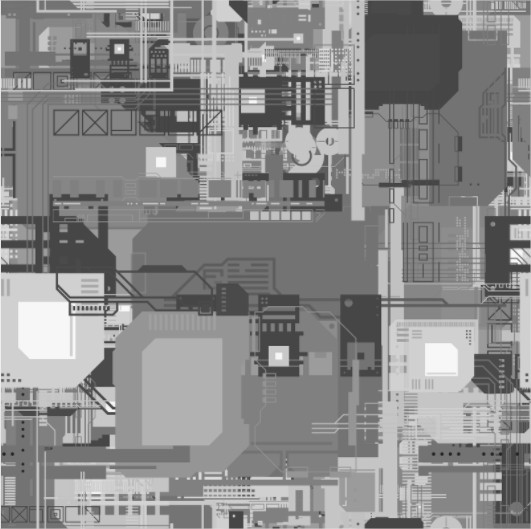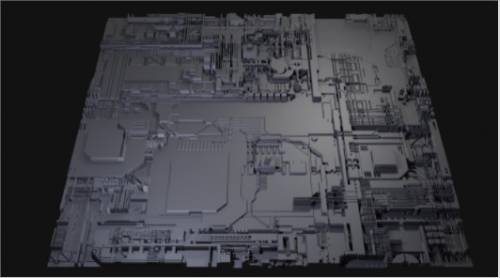このディスプレイスメントをスカルプトまたは「ペイント」することにより、モデルに高レベルの「実際の」ディスプレイスメントを提供する必要がある場合、使用する最適なモードは「Microvertex」モードです。
ディスプレイスメントmappingは、バンプmapping、法線mapping、および視差mappingとは対照的に、テクスチャまたは高さマップを使用して、テクスチャ サーフェス上のポイントの実際の幾何学的位置が、多くの場合ローカル サーフェスに沿って変位する効果を引き起こす代替のコンピュータ グラフィックス手法です。通常、テクスチャ関数がサーフェス上の各ポイントで評価する値に従います。
サーフェスに優れた深みとディテールを与え、セルフ オクルージョン、セルフ シャドウイング、およびシルエットを可能にします。一方、追加のジオメトリが大量にあるため、このクラスの手法の中で最もコストがかかります。
ディスプレイスメント マップを使用すると、ペイントされたオブジェクトの表面のグリッド ポイントをシフトできます。この技法は、硬い表面に色の深みやレリーフを作成するために使用されます。これにより、テクスチャをより詳細に描画し、影と明確なシルエットを作成できます。
normal mapは、照明をシミュレートするために使用されます。このツールを使用すると、折り目やくぼみの粗さと深さを作成できます。この機能を使用すると、3D モデルに多くの細かいディテールを追加することもできます。
ディスプレイスメントは、高さマップのピクセルの色に基づいて個々の頂点を上下に移動するのに十分なジオメトリ (面) がオブジェクト サーフェスにある場合にのみ機能します。
デザイナーがローポリ モデルを使用する場合、ディスプレイスメント マップとそれが作成する効果は実質的に見えません。したがって、この場合、そのような徹底的な描画は意味がありません。ハイポリモデルを使用すると、その可能性が最大限に発揮されます。
このアプローチでは、すべての面 (四角形のみ許可) が N x M 個の頂点のパッチとして表されました (N と M は面ごとに異なる可能性があります)。
すべての頂点には空間内の色と座標があるため、あらゆる変位が許可されていました。ただし、四角形以外の面でメッシュを編集するのは非常に困難だったため、このアプローチには限界がありました。パッチをテクスチャに投影すると品質が低下するため、テクスチャをimportて編集し、エクスポート後のテクスチャがわずかにぼやけて見えるため、exportのが困難でした。そこで、per-pixelのペイントを実装することにしました。
このモードでは、テクスチャまたはスカルプティングによって追加した極端なレベルのディスプレイスメントを正確に反映する、標準またはベクトル ベースのディスプレイスメント マップをexportます。
マイクロ頂点 (ディスプレイスメント) ペインティングは、一時的な「ビューポート メッシュ」を実際に変更します。これは、この一時的なメッシュに実際のディスプレイスメントと実際のディスプレイスメントを適用するベース メッシュのユーザー定義の細分化バージョンです。
モデルとそれに関連するテクスチャをexportと、完成したメッシュ密度を設定するオプションが与えられます。モデルがビューポートでリアルタイムに達成されたディスプレイスメントを正確に表現できるようにするには、適切なポリゴン密度 (数十または数十万のポリゴン) を与えるようにしてください。
2k テクスチャ マップには 4M で十分です。 4k マップの場合は、できるだけ高くします。
チュートリアル
複数の Real Displacement Textures を使用したPainting(簡単な説明) :これは、Christoph Schindelar の素晴らしい 4-8K の「Real Displacement Textures」を3DCoatで使用してテッセレーションされたディスプレイスメントでペイントする方法に関する簡単なチュートリアルです。さらに、IBL (画像ベースの照明) を使用して、モデルを背景画像で照らし、写真に含まれているように見えるようにするだけでなく、作品を想像するのにも役立ちます。
Import to Microvertex Options Notes :このビデオでは、MicroVertex (displacement mapの詳細チャネル) オプションを使用してモデルをPaintingルームにインポートする際の重要な注意事項について説明しています。
ディスプレイスメント マップとはChipp Walters によると、ディスプレイスメントは、高さマップのピクセルの色に基づいて個々の頂点を上下に移動するのに十分なジオメトリ (面) がオブジェクト サーフェスにある場合にのみ機能します。
ディスプレイスメントでは、グレースケール イメージを使用して重要なトポロジを生成します。
グレースケールの「マップ」の例を次に示します。これを作成するために素晴らしい (そして無料の) アプリ JSplacement を使用したことに注意してください。

displacement mapが正しく適用されると、グレースケール イメージの明るい領域が暗い領域よりも「高く」なることがわかります。

 日本語
日本語  English
English Українська
Українська Español
Español Deutsch
Deutsch Français
Français Русский
Русский 한국어
한국어 Polski
Polski 中文 (中国)
中文 (中国) Português
Português Italiano
Italiano Suomi
Suomi Svenska
Svenska 中文 (台灣)
中文 (台灣) Dansk
Dansk Slovenčina
Slovenčina Türkçe
Türkçe Nederlands
Nederlands Magyar
Magyar ไทย
ไทย हिन्दी
हिन्दी Ελληνικά
Ελληνικά Tiếng Việt
Tiếng Việt Lietuviškai
Lietuviškai Latviešu valoda
Latviešu valoda Eesti
Eesti Čeština
Čeština Română
Română Norsk Bokmål
Norsk Bokmål